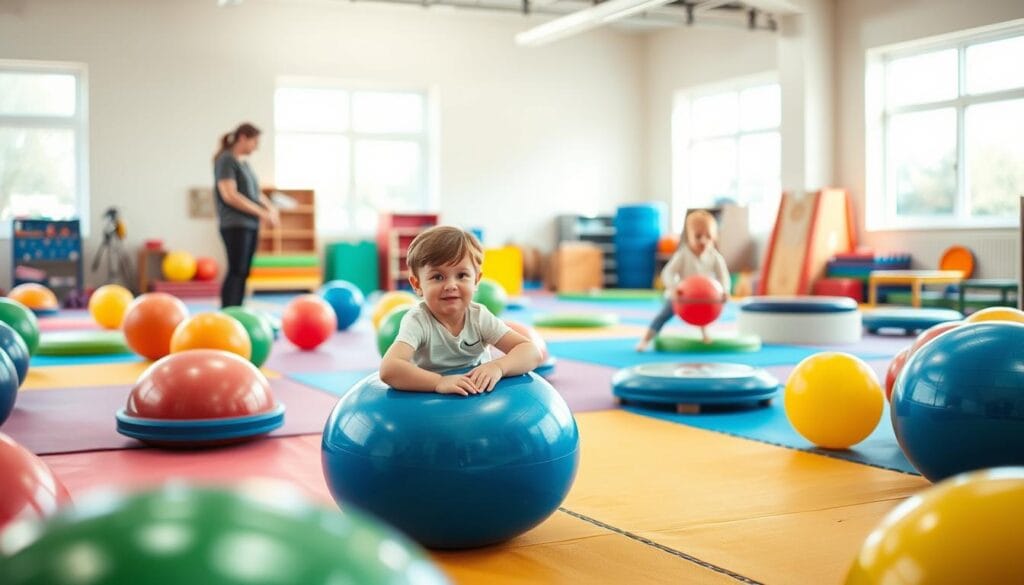Did you know that over 1 in 54 children in the United States are diagnosed with autism spectrum disorder (ASD)? This statistic highlights the growing need for effective tools to support children with autism in their daily lives. Among these tools, therapy balls have emerged as a simple yet powerful solution.
How Therapy Balls Help Autism is at the heart of this guide, showcasing how these tools can make a meaningful difference. Therapy balls, also known as exercise balls, are increasingly used in both classrooms and home settings to provide sensory input and stability for children with autism. These balls are designed to help children regulate their energy levels and improve focus during activities. By incorporating a therapy ball into daily routines, parents and educators can create a more supportive environment for learning and development.
In this guide, we will explore the benefits of therapy balls, how they can be integrated into various activities, and why they are becoming an essential tool for many families and educators. Whether you’re a parent seeking new ways to support your child or an educator looking to enhance classroom experiences, this guide will provide you with the insights you need to make informed decisions.
Table of Contents
Key Takeaways
- Therapy balls provide essential sensory input for children with autism.
- These balls can improve stability and focus in both classroom and home settings.
- Incorporating a therapy ball into daily activities can help regulate energy levels.
- Therapy balls are a versatile tool for supporting learning and development.
- They offer a simple, effective solution for parents and educators alike.
Understanding Therapy Balls and Their Role in Autism
Therapy balls are an essential tool for many children with autism, offering a simple yet effective way to provide sensory input and stability. These balls, also known as exercise balls, are designed to help children regulate their energy levels and improve focus during activities. By incorporating a therapy ball into daily routines, parents and educators can create a more supportive environment for learning and development.
How Therapy Balls Help Autism
Therapy balls are large, inflatable balls designed to support various therapeutic activities. They are typically made of durable rubber and can be adjusted to different sizes and firmness levels to suit a child’s needs. The ball’s design allows for dynamic movement, which helps provide multisensory input. This input is crucial for children with autism, as it helps them process sensory information more effectively.
The ball’s properties, such as its texture and size, play a significant role in providing balanced sensory input. For example, the gentle bounce of the ball can stimulate the vestibular system, which is responsible for balance and spatial orientation. This stimulation can help children develop better body awareness and coordination.
The Importance of Sensory and Vestibular Input
Sensory input is vital for children with autism, as it helps them process and respond to information from their environment. Therapy balls provide a unique way to deliver this input, engaging multiple senses simultaneously. The combination of movement, pressure, and balance stimulates the sensory and vestibular systems, promoting overall stability and focus.
| Benefit | Mechanism | Outcome |
|---|---|---|
| Sensory Input | Multi-sensory stimulation | Improved processing and integration of sensory information |
| Vestibular Stimulation | Gentle bouncing and rocking | Enhanced balance and spatial awareness |
| Energy Regulation | Physical activity and movement | Reduced hyperactivity and improved focus |
These benefits make therapy balls a valuable tool in both classroom and home settings, providing structured environments where children can thrive.
How do therapy balls help autism: Key Benefits and Mechanisms
Therapy balls offer a wide range of benefits for children with autism, particularly in enhancing motor skills and emotional regulation. These tools are designed to provide sensory input that can help children manage their energy levels and improve focus during activities. By incorporating a therapy ball into daily routines, parents and educators can create a more supportive environment for learning and development.
Enhancing Motor Skills and Stability
Therapy balls play a crucial role in improving motor skills and stability in children with autism. The dynamic movement of the ball engages multiple muscle groups, promoting strength and coordination. Activities such as bouncing and rocking on the ball stimulate the vestibular system, which is essential for balance and spatial orientation. This stimulation can lead to better body awareness and overall physical stability.
Additionally, therapy balls can be used in prone and supine positions to enhance postural control. These positions help strengthen core muscles, which are vital for maintaining good posture and balance. The gentle pressure from the ball provides sensory feedback, helping children develop better control over their movements.
Promoting Emotional Regulation and Focus
Emotional regulation is another area where therapy balls prove to be highly effective. The repetitive motion of rocking or bouncing on the ball can be calming, helping children manage stress and anxiety. This calming effect often leads to improved focus and attention span, making it easier for children to engage in educational activities.
The combination of physical activity and sensory input from the therapy ball helps children regulate their energy levels. This regulation can reduce hyperactivity and improve overall behavior in both classroom and home settings. By providing a structured outlet for movement, therapy balls offer a practical solution for supporting emotional well-being and academic performance.
| Benefit | Mechanism | Outcome |
|---|---|---|
| Motor Skills Development | Dynamic movement and muscle engagement | Improved strength, coordination, and balance |
| Emotional Regulation | Calming repetitive motion and sensory feedback | Reduced stress and anxiety, better focus |
| Energy Regulation | Physical activity and sensory input | Reduced hyperactivity, improved behavior |
Effective Therapy Ball Activities for Enhancing Sensory and Motor Skills
Engaging in activities with a therapy ball can be a fun and effective way to support your child’s sensory and motor development. These activities are designed to provide dynamic input while being adaptable to your child’s needs and preferences.
Bouncing and Rocking for Vestibular Stimulation
Bouncing and rocking on a therapy ball offers dynamic vestibular stimulation, which can help your child improve their balance and spatial awareness. This activity can be adjusted to either energize or calm your child, depending on the intensity and rhythm of the movement. Regular use of the ball in this way can lead to better focus and emotional regulation.
Prone and Supine Lying Positions for Postural Control
Using the therapy ball in prone and supine positions can help your child develop postural control and endurance. In the prone position, your child can engage in activities like reaching or drawing, while in the supine position, they can work on controlled movements. These exercises strengthen core muscles, which are essential for maintaining good posture and balance.
Rolling and Pressure Techniques to Calm and Engage
Rolling the therapy ball gently over your child’s arms, legs, or back can provide a calming sensory experience. This activity can help reduce stress and anxiety while promoting relaxation. The pressure from the ball offers tactile feedback, which can be particularly soothing for children seeking deep pressure input.

| Activity | Benefits | Outcome |
|---|---|---|
| Bouncing and Rocking | Dynamic movement and vestibular stimulation | Improved balance and focus |
| Prone and Supine Positions | Core strengthening and postural control | Enhanced endurance and posture |
| Rolling and Pressure | Deep pressure input and tactile feedback | Reduced anxiety and improved relaxation |
Incorporating these activities into your child’s daily routine can create a structured and supportive environment for their development. Whether in the classroom or at home, these exercises offer a practical way to boost motor skills and emotional well-being.
Selecting the Perfect Therapy Ball for Your Child’s Needs
Choosing the right therapy ball for your child involves considering several factors to ensure comfort, safety, and effectiveness. The ball should cater to your child’s physical and sensory needs, providing the right amount of support and stimulation.
Choosing the Right Size, Texture, and Support
The size of the ball is crucial. A ball that is too small may not provide adequate support, while one that is too large can be unstable. Opt for a ball with a diameter of 45-55 cm for children under 60 inches tall and 55-65 cm for taller children. The texture should offer a comfortable grip without causing irritation.
Support is another key factor. Some balls come with handles, which can aid in stability and make certain activities easier. The level of firmness should be adjustable to meet your child’s needs, ensuring the ball provides the right amount of pressure for sensory input.
Safe Practices in Classroom and Home Settings
In both classroom and home settings, ensure the area is clear of breakable items. Supervision is essential to prevent accidents. Teach your child to sit with feet flat on the floor and hands on the ball for stability.
| Size | Texture | Support | Outcome |
|---|---|---|---|
| 45-55 cm | Non-slip surface | Handles for stability | Improved posture and balance |
| 55-65 cm | Soft, durable material | Adjustable firmness | Enhanced sensory input |

By considering size, texture, and support, you can select a therapy ball that meets your child’s needs, promoting strength, skill development, and sensory integration in a safe environment.
Conclusion
In conclusion, therapy balls offer a simple yet powerful way to support children with autism by providing essential sensory input and stability. These tools are versatile, benefiting both classroom and home environments. By incorporating a therapy ball into daily routines, you can help your child improve focus, regulate energy levels, and develop motor skills.
The connection between physical activity and emotional regulation is key. Activities like bouncing, rocking, and rolling provide dynamic sensory input, which can calm and engage your child. Remember to choose the right size and texture for their needs, ensuring comfort and safety in any setting.
Whether in a classroom or at home, therapy balls are a practical solution for supporting your child’s development. Explore these techniques further and help your child or group reach their full potential in both academic and personal growth.
Discover also our post: A Parent’s Guide to Autism : Essential Tips and Resources
